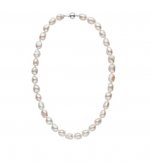You are using an out of date browser. It may not display this or other websites correctly.
You should upgrade or use an alternative browser.
You should upgrade or use an alternative browser.
Tissue nucleated cfwp
- Thread starter Jaye
- Start date
Pearl Dreams
Pearl Enthusiast
There are lots of tissue nucleated baroque freshwater pearls out there-- I believe these are still the majority, especially in the smaller sizes. Often they are less round than the bead-nucleated ones.
Lower quality bead nucleated fwp have rippled surfaces and major blemishes. I see them all the time at places like T. J. Maxx.
Lower quality bead nucleated fwp have rippled surfaces and major blemishes. I see them all the time at places like T. J. Maxx.
jshepherd
Pearl Paradise
Yes, they are still readily available and there are several different types. Are you referring more to a free-form shaped baroque? They are tissue nucleated and there are two general types: one that grew away from the shell in the mantle so are smooth on all sides, and those that grew against the shell and have one non-smooth side.
Other shapes like potato can also be baroque if they have no access of symmetry.
If the pearls have a bulbous side, they are beaded baroques. If more like souffle, they are still considered beaded baroques (atypical beaded cultured freshwater pearls) even though the nucleus doesn't remain in the pearl.
Other shapes like potato can also be baroque if they have no access of symmetry.
If the pearls have a bulbous side, they are beaded baroques. If more like souffle, they are still considered beaded baroques (atypical beaded cultured freshwater pearls) even though the nucleus doesn't remain in the pearl.
Thank you PD and Jeremy.
As I understand from your answer, it seems that the shape that I love, baroque bulbous drops, pear shapes found in SouthSea, would be bead nucleated.
And the chinese Ripple pearls that look like Kasumi are bead nucleated also?
As I understand from your answer, it seems that the shape that I love, baroque bulbous drops, pear shapes found in SouthSea, would be bead nucleated.
And the chinese Ripple pearls that look like Kasumi are bead nucleated also?
Pearl Dreams
Pearl Enthusiast
ericw
New Member
I wonder if is there not always necessary to include a little piece of tissue against the bead, that to induce pearl response, producing nacre first on the tissue, next moving along the bead until to fully cover it?
Pearl Dreams
Pearl Enthusiast
Yes, they always include a graft of donor mantle tissue when implanting a bead (unless there is already a pearl sac from a previously harvested pearl.) The donor tissue leads to the formation of the pearl sac.
Pearl Dreams
Pearl Enthusiast
Value factors that affect the price difference include:
• Shape. All-nacre pearls are usually not round; and even pearls with a bead nucleus are often not round. Roundness is not only more rare but also generally more desired by the buying public, hence the higher price.
• Luster. While some FWP have beautiful luster, in general fwp from China have lower luster than, say, akoyas, because they are cultivated in warmer waters. The aragonite crystals (nacre) that the mussel lays down are larger. Think of it as larger pixels.
• Surface-- a lot of baroque pearls have an imperfect surface.
• Shape. All-nacre pearls are usually not round; and even pearls with a bead nucleus are often not round. Roundness is not only more rare but also generally more desired by the buying public, hence the higher price.
• Luster. While some FWP have beautiful luster, in general fwp from China have lower luster than, say, akoyas, because they are cultivated in warmer waters. The aragonite crystals (nacre) that the mussel lays down are larger. Think of it as larger pixels.
• Surface-- a lot of baroque pearls have an imperfect surface.
All true, imo! In addition, many pearls can be nucleated in the mantle tissue of the freshwater mussel, which makes them cost effective. Fw mussels are also easier to grow than salt water oysters, which are very sensitive to their environment, food, etc. At one time I heard 25-50 tissue nucleated pearls per mussel. Salt water bead nucleated pearls 1, or in some circumstances, 2. Now with the bead nucleated fw, the yield has changed as they are grafted in a different part of the mussel.
ericw
New Member
Just I must add that FWP nacre is harder than saltwater pearls like south sea or tahitian. I don't know why, but there's a great difference, maybe the size of aragonite crystals?
GemGeek
Pearlista
Do you mean more resistant to carving?
ericw
New Member
Do you mean more resistant to carving?
Yes, GemGeek, FWP are harder to carve than saltwater pearls (I can't tell that about akoya's, I have never tried to carve one). It's looking like FWP nacre contains less quantity of conchyoline, a soft material. I also think that because when you move together several thick nacre FWP in your hand, they sound more than tahitian or south sea pearls.
Edit: however, Edison pearls, FWP too, are softer than the other FWP I have worked... I don't understand why, but carving of their nacre looks like saltwater's one.
Anyway, white or pale coloured pearls are usually harder to carve than strong coloured.
Last edited:
Similar threads
- Replies
- 24
- Views
- 2K

